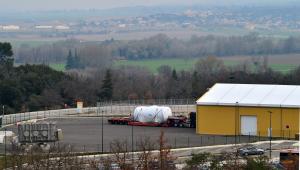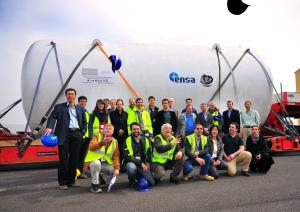Right on time for the eclipse
Arriving from Santander, Spain, the convoy passed the gate to the ITER storage area at the very moment the eclipse reached its maximum. As a dull, ashen light fell on the surrounding countryside, the truck and its load came to a halt—the first equipment procured by the European Domestic Agency had safely reached its destination.
Manufactured by the Spanish company ENSA, the load consisted of a 20-tonne, 100 m³ tank destined for the ITER detritiation system. It is one of two "emergency tanks" that will collect the tritiated water in case an abnormal situation develops during operations (the second will be delivered in April).
The tank that was delivered on 20 March will be the first Safety Important Component to be installed in the Tokamak Complex. "The fact that the emergency tanks are being delivered now means that we will be able to install them before the next level is poured," explained Manfred Glugla, head of the ITER Fuel Cycle Engineering Division.



